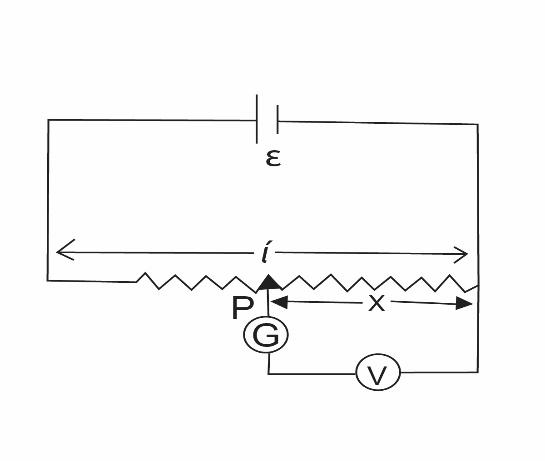
Answer
108k+ views
Hint:In this question, draw the circuit diagram and then use the definition and expression of potential gradient and internal resistance and then find the potential difference and the internal resistance of the circuit.
Complete step by step solution:
Let us consider the diagram of the potentiometer as,

In this question, the null point is given as $X = 0.75{\text{m}}$
A) We know that potential gradient of a cell is the potential drop per unit length. It is expressed as $ \Rightarrow K = \dfrac{V}{l}$
where $K$ is potential gradient, $V$ is voltage and $l$ is the length
Potential gradient,
Now, we substitute the values in the above equation as,
$ \Rightarrow K = \dfrac{{12}}{1} = 12$
Now we will calculate the potential difference as,
$ \Rightarrow V = KL$
Where, $L$ is the null point distance
Now, we will substitute the values as,
$ \Rightarrow V = 12 \times 0.75$
After calculation, we will get
$\therefore V = 9\;{\text{V}}$
Hence, the potential difference is $9V.$
B) As we know that the internal resistance of a cell is opposition to the current flow provided by the cells and batteries which results in the generation of heat in the circuit.
The expression of internal resistance in an electrical circuit is $E = I\left( {r + R} \right)$
$ \Rightarrow E = Ir + IR$
$ \Rightarrow E = Ir + V$
Where $r$ - the internal resistance of an electrical circuit, $E$ is the electromotive force, so in this case $V$ is the E. M.F of the cell.
Hence,
$E = V + Ir$
$ \Rightarrow E = E + Ir$
After calculation we get
$\therefore r = 0$
Thus, the internal resistance of the circuit is Zero.
Note:The potential gradient mainly depends on various properties such as-i) Current passing through the potentiometer wire ii) Specific resistance of the material of the potentiometer iii) Area of cross section of the potentiometer wire. Internal resistance is used to limit the current flow in a circuit to prevent the short circuit problem in an electrical circuit.
Complete step by step solution:
Let us consider the diagram of the potentiometer as,

In this question, the null point is given as $X = 0.75{\text{m}}$
A) We know that potential gradient of a cell is the potential drop per unit length. It is expressed as $ \Rightarrow K = \dfrac{V}{l}$
where $K$ is potential gradient, $V$ is voltage and $l$ is the length
Potential gradient,
Now, we substitute the values in the above equation as,
$ \Rightarrow K = \dfrac{{12}}{1} = 12$
Now we will calculate the potential difference as,
$ \Rightarrow V = KL$
Where, $L$ is the null point distance
Now, we will substitute the values as,
$ \Rightarrow V = 12 \times 0.75$
After calculation, we will get
$\therefore V = 9\;{\text{V}}$
Hence, the potential difference is $9V.$
B) As we know that the internal resistance of a cell is opposition to the current flow provided by the cells and batteries which results in the generation of heat in the circuit.
The expression of internal resistance in an electrical circuit is $E = I\left( {r + R} \right)$
$ \Rightarrow E = Ir + IR$
$ \Rightarrow E = Ir + V$
Where $r$ - the internal resistance of an electrical circuit, $E$ is the electromotive force, so in this case $V$ is the E. M.F of the cell.
Hence,
$E = V + Ir$
$ \Rightarrow E = E + Ir$
After calculation we get
$\therefore r = 0$
Thus, the internal resistance of the circuit is Zero.
Note:The potential gradient mainly depends on various properties such as-i) Current passing through the potentiometer wire ii) Specific resistance of the material of the potentiometer iii) Area of cross section of the potentiometer wire. Internal resistance is used to limit the current flow in a circuit to prevent the short circuit problem in an electrical circuit.
Recently Updated Pages
If x is real then the maximum and minimum values of class 10 maths JEE_Main

If one of the roots of equation x2+ax+30 is 3 and one class 10 maths JEE_Main

The HCF of two numbers is 96 and their LCM is 1296 class 10 maths JEE_Main

The height of a cone is 21 cm Find the area of the class 10 maths JEE_Main

In a family each daughter has the same number of brothers class 10 maths JEE_Main

If the vertices of a triangle are ab cc b0 and b0c class 10 maths JEE_Main

Other Pages
Electric field due to uniformly charged sphere class 12 physics JEE_Main

If a wire of resistance R is stretched to double of class 12 physics JEE_Main

Lattice energy of an ionic compound depends upon A class 11 chemistry JEE_Main

The graph of current versus time in a wire is given class 12 physics JEE_Main

A 5m long pole of 3kg mass is placed against a smooth class 11 physics JEE_Main

As a result of isobaric heating Delta T 72K one mole class 11 physics JEE_Main




